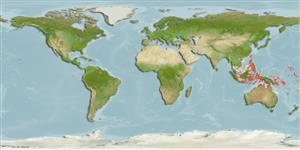Teleostei (teleosts) >
Blenniiformes (Blennies) >
Blenniidae (Combtooth blennies) > Salariinae
Etymology: Salarias: Latin, salar, salaris = trout (Ref. 45335).
Environment: milieu / climate zone / depth range / distribution range
Ecology
Marine; reef-associated; depth range 0 - 5 m (Ref. 90102). Tropical
Western Central Pacific: Australia, Indonesia, Philippines.
Size / Weight / Age
Maturity: Lm ? range ? - ? cm
Max length : 5.5 cm TL male/unsexed; (Ref. 36661)
Short description
Morphology | Morphometrics
Dorsal
spines
(total): 12;
Dorsal
soft rays
(total): 17-18;
Anal
spines: 2;
Anal
soft rays: 19. Body coloration with 8 pairs of irregular, olive-brown bars and numerous small white spots (particularly on anterior half), breast with large white spot (no defined dark margin), and 2 large dark spots on throat. Segmented caudal rays, 13, with middle 9 branched; supraorbital tentacle with slender base, tip bifid with secondary branches; palmate nape cirrus; nasal cirrus, simple lanceolate filament; upper and lower lip margins smooth; lacking an occipital crest; last anal ray and caudal peduncle connected by membrane; body depth at anal-fin origin 4.6-5.5 in SL (Ref. 90102).
Facultative air-breathing (Ref. 126274); Adults are found solitary on corals both live and dead ones (Ref. 90102). They graze on epilithic algae along with the accompanying detritus and sediment (Ref. 94105). Oviparous. Eggs are demersal and adhesive (Ref. 205), and are attached to the substrate via a filamentous, adhesive pad or pedestal (Ref. 94114). Larvae are planktonic, often found in shallow, coastal waters (Ref. 94114).
Life cycle and mating behavior
Maturity | Reproduction | Spawning | Eggs | Fecundity | Larvae
Oviparous, distinct pairing (Ref. 205).
Allen, G.R., 1997. The marine fishes of tropical Australia and south-east Asia. Western Australian Museum, Perth, Western Australia. 292 p. (Ref. 36661)
IUCN Red List Status (Ref. 130435)
Threat to humans
Harmless
Human uses
More information
ReferencesAquacultureAquaculture profileStrainsGeneticsElectrophoresesHeritabilityDiseasesProcessingNutrientsMass conversion
Tools
Special reports
Download XML
Internet sources
Estimates based on models
Preferred temperature (Ref.
123201): 26 - 29.3, mean 28.7 °C (based on 1621 cells).
Phylogenetic diversity index (Ref.
82804): PD
50 = 0.5001 [Uniqueness, from 0.5 = low to 2.0 = high].
Bayesian length-weight: a=0.00741 (0.00335 - 0.01640), b=3.02 (2.83 - 3.21), in cm total length, based on LWR estimates for this (Sub)family-body shape (Ref.
93245).
Trophic level (Ref.
69278): 2.0 ±0.00 se; based on food items.
Resilience (Ref.
120179): High, minimum population doubling time less than 15 months (Preliminary K or Fecundity.).
Fishing Vulnerability (Ref.
59153): Low vulnerability (10 of 100).
